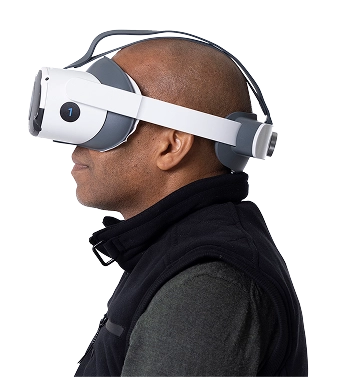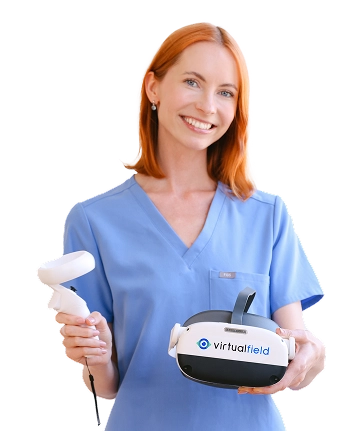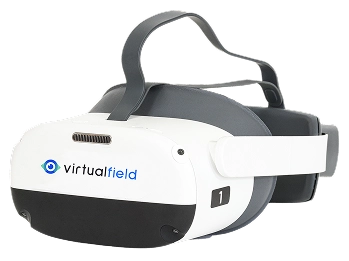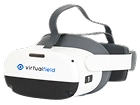Every eye exam begins with a measurement of visual acuity. It’s fast, simple, and can open the door for a whole host of further exams and assessments. It is a fundamental component of physical wellness exams, even in non-eye care settings.
To begin routine screenings, choose from a wide range of visual acuity tests, like the Snellen, pinhole, random E, or ETDRS visual acuity chart. Begin routine screenings with a visual acuity screening device like the Snellen or ETDRS chart. For schools, clinics, or community programs, a school vision screening tool such as a portable vision chart ensures efficient and accessible testing across settings. Then round out your exceptional exams with Virtual Field for visual field testing, color vision, pupillometry, and other specialty eye exams.
This guide covers the details of visual acuity testing and its applications.
How a Visual Acuity Screening Device Measures Vision Sharpness
Visual acuity measures the spatial resolution of the eye under high-contrast conditions, identifying the smallest letters a patient can read at a specified distance.
A visual acuity screening device may come in many forms: mounted wall charts, handheld cards, or digital tablets. Whether you're conducting exams in a clinical environment or a school setting, using a portable vision chart ensures consistent results without depending on fixed infrastructure.
Standardized charts and procedures ensure that testing is consistent across clinics. These are a few of the most common:
• Snellen chart. In use since 1862, this ubiquitous wall chart presents rows of letters in decreasing size, which patients read aloud.
• Early Treatment Diabetic Retinopathy Study (ETDRS) visual acuity test. The ETDRS test is similar to the Snellen chart, but is more precise and often used in clinical trials.
• Random E. A repeating letter E appears in different directions while decreasing in size. Less common than the Snellen test, this option is often used for children and individuals who struggle to identify letters.
• Pediatric visual acuity tests. These school vision screening tools use familiar shapes and objects to test young children or patients who can’t recognize letters.
• Pinhole visual acuity test. You can differentiate if a decrease in vision is due to a refractive error or pathology using the pinhole test by having patients use a specialized paddle and asking them to read one of the standard charts above.
• Dynamic visual acuity test. DVA can help measure visual acuity while the head is in motion, which is very useful for assessing vestibular function.
The most common test is the Snellen chart, used at a distance of 20 feet. The result is expressed as a fraction, with 20/20 being the benchmark. Contrary to patients’ common belief, 20/20 does not indicate perfect vision but the average. A myopic result of 20/40 means the person sees at 20 feet what a typical person can see at 40 feet. Sharper visual acuity is represented with a lower secondary number.
Visual acuity can be tested with or without correction. Best-corrected visual acuity (BCVA) is used to determine the sharpest vision a person can achieve with corrective lenses, i.e., glasses or contacts. This evaluation can help us identify if the patient’s decreased vision is due to an underlying ocular pathology or a refractive error.
Academic references and clinical validation
A recent study showed that smartphone-based eye charts may be a viable alternative for testing when in-office screenings are unavailable. However, a comparison survey underscores the importance of caution when comparing different charts.
The CDC recommends conducting comprehensive eye exams every two years for adults aged 60 and older, as well as for individuals at risk of glaucoma. Patients with diabetes should undergo annual exams.
Depending on age, the prevalence of vision loss (20/40 or worse) ranges from 0.73% to over 20%. Around 1/3 of Americans have 20/20 normal vision. High visual acuity is very uncommon, but interestingly, overrepresented in athletes.
Virtual Field is proud to be the most trusted virtual visual field provider in the United States and Canada.


30 days free.
No strings attached.
We are confident you’ll love Virtual Field just like the 2,000 doctors who have already made the switch.
Visual Acuity vs. Visual Field: Understanding Vision Screening Devices
While both tests are used in diagnostics, visual acuity screening devices assess clarity of central vision, whereas field tests measure peripheral awareness. Visual field testing also assesses the extent to which a patient can perceive their surrounding environment. This insight helps detect issues such as glaucoma or neurological damage, whereas visual acuity measures whether patients require corrective lenses.
Pros and Cons of Visual Acuity Testing
The pros and cons that follow can help guide you toward the ideal scenarios to incorporate this test into your patients' diagnostic assessments.
Pros
Quick and easy to administer using a visual acuity screening device, including options suitable for school and clinical settings.
This screening helps detect and monitor a wide range of eye conditions.
Establish a standardized baseline for patient visual performance with simple acuity tests.
Visual acuity testing is a non-negotiable requirement for licensing, workplace evaluations, school screenings, and most routine physical examinations.
Portable vision charts offer flexibility for screenings in nontraditional settings like school gyms, mobile clinics, and health fairs.
Cons
Visual acuity testing can be conducted using multiple charts and formats, so it is essential to standardize the data.
These tests are limited to high-contrast central vision and cannot provide insight into peripheral vision, contrast sensitivity, night vision, or color vision.
Results can appear normal in patients with significant eye conditions, such as glaucoma or age-related macular degeneration (AMD).
Visual acuity testing relies on the patient's literacy and understanding of the Latin alphabet.
Eye Conditions Identified by Visual Acuity Screening
A visual acuity screening device is the first step in detecting a wide range of eye diseases, especially during school vision screenings or routine physicals.
Refractive Errors
Myopia, hyperopia, astigmatism, and presbyopia can be accurately diagnosed through visual acuity testing. From here, you can begin the corrective lens prescription process.
Cataracts
Progressive opacity in the lens often causes a gradual decline in visual acuity. Cataract severity is often graded based on visual acuity thresholds.
Diabetic Retinopathy
In later stages, diabetic macular edema can impair visual acuity. Routine testing helps detect functional changes before they lead to structural damage.

60+
Macular Degeneration is the leading cause of vision loss in Americans aged 60 and older
2.5M
AMD affects 2.5 million Canadians
Amblyopia and Strabismus
Underdeveloped visual pathways or vision suppression can occur from misaligned eyes. In some cases, amblyopia isn’t noticeable except during visual acuity testing.
Macular Degeneration
Early macular degeneration commonly presents with difficulty seeing in low light or scotomas in the visual field. In later stages, visual acuity can be impacted.
Optic Neuritis
Acute vision loss, especially unilateral, may first be detected as reduced visual acuity. Tracking fluctuations can help monitor recovery or progression.
Example Visual Acuity Test
30 days free.
No strings attached.
We are confident you’ll love Virtual Field just like the 2,000 doctors who have already made the switch.

Billing and CPT Codes for Visual Acuity Screening Devices
Use CPT codes 92004 (new patient) and 92014 (established patient) to bill for eye exams. The CMS fee schedule indicates reimbursement between $110 and $184, depending on your practice’s location, type, and setting. Note that this fee covers comprehensive ophthalmologic exams, not visual acuity alone.
When is the visual acuity test required?
This test is central to almost every eye exam — it’s even a standard component of regular physical checkups. Conduct visual acuity tests for new and returning patients of all ages, people seeking driver’s licenses, people who have experienced an injury or surgery that could affect vision, and any patients complaining of visual disturbances or difficulties.
Is visual acuity testing required for driver’s licenses?
Each state has its own threshold, but most require a minimum best corrected visual acuity of 20/40 or better in at least one eye. Many also require a visual field of 70 degrees on the horizontal meridian. A few states have low visual acuity thresholds for exceptions and special licenses. The Esterman exam is one of the most-used tests for driver’s licensing, especially when combined with a standard eye chart.
Combine Visual Acuity Screening with Virtual Field for Full Vision Exams
Exceptional eye exam experiences should be comfortable, patient-friendly, and comprehensive. Start with a visual acuity screening device to measure central vision and identify refractive errors. Whether you’re using a portable vision chart for school screenings or an ETDRS chart in a hospital, visual acuity lays the foundation. Then, add Virtual Field for a more complete picture of ocular function, including visual field and specialty testing.
Want all 23 exam guides in one place?
Download our comprehensive guide for 160+ pages of insights.
FAQs
1. Is a digital Snellen chart acceptable for school vision screening mandates?
2. What CPT code applies to acuity-only screening?
3. Why doesn't Virtual Field offer a visual acuity test?
4. Is a minimum pupil or refractive status required with a visual acuity test?
Ready to get started?
Schedule a demo or begin your 30-day free trial of Virtual Field to try our EOM exam in your practice.

Questions? Contact sales@virtualfield.io talk to a Virtual Field expert today.



